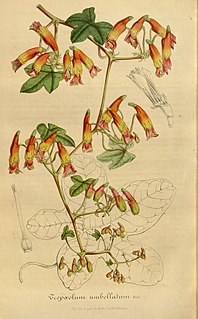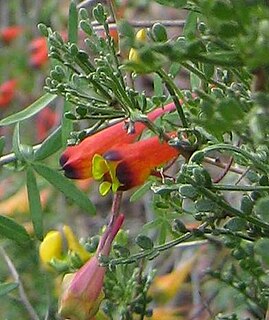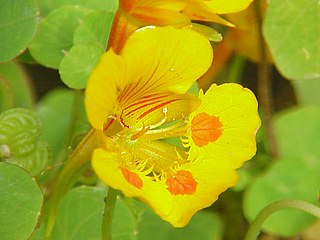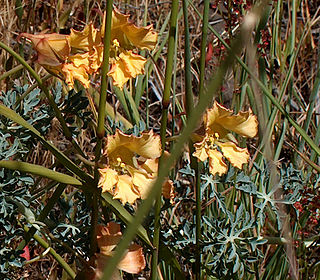
Tropaeolum, commonly known as nasturtium, is a genus of roughly 80 species of annual and perennial herbaceous flowering plants. It was named by Carl Linnaeus in his book Species Plantarum, and is the only genus in the family Tropaeolaceae. The nasturtiums received their common name because they produce an oil similar to that of watercress.

Tropaeolum tuberosum is a species of flowering plant in the family Tropaeolaceae, grown in the Andes, particularly in Peru and Bolivia, and to a lesser extent in Ecuador as well as in some areas of Colombia, for its edible tubers, which are eaten cooked or roasted as a vegetable. It is a minor food source, especially to native Amerindian populations. Mashua is a herbaceous perennial climber growing to 2–4 m (7–13 ft) in height. It is related to garden nasturtiums, and is occasionally cultivated as an ornamental for its brightly coloured tubular flowers.

Tropaeolum majus, the garden nasturtium, nasturtium, Indian cress or monks cress, is a species of flowering plant in the family Tropaeolaceae, originating in the Andes from Bolivia north to Colombia. An easily-grown annual or short-lived perennial with disc-shaped leaves and brilliant orange or red flowers, it is of cultivated, probably hybrid origin. It is not closely related to the genus Nasturtium.

The Canary Islands large white is a species of butterfly in the family Pieridae. It is endemic to the Canary Islands (Spain).

Helicia is a genus of 110 species of trees and shrubs, constituting part of the plant family Proteaceae. They grow naturally in rainforests throughout tropical South and Southeast Asia, including India, Sri Lanka, Indochina, Peninsular Malaysia to New Guinea and as far south as New South Wales.
Tropaeolum asplundii is a species of plant in the Tropaeolaceae family. It is endemic to Ecuador. Its natural habitat is subtropical or tropical moist montane forests.
Tropaeolum carchense is a species of plant in the Tropaeolaceae family. It is endemic to Ecuador. Its natural habitat is subtropical or tropical high-altitude grassland.
Tropaeolum huigrense is a species of plant in the Tropaeolaceae family. It is endemic to Ecuador. Its natural habitat is subtropical or tropical moist montane forests.
Tropaeolum leonis is a species of plant in the Tropaeolaceae family. It is endemic to Ecuador. Its natural habitat is subtropical or tropical moist montane forests.
Tropaeolum magnificum is a species of plant in the Tropaeolaceae family. It is endemic to Ecuador. Its natural habitats are subtropical or tropical moist montane forests and subtropical or tropical high-altitude grassland.
Tropaeolum menispermifolium is a species of plant in the Tropaeolaceae family. It is endemic to Ecuador. Its natural habitat is subtropical or tropical high-altitude grassland.
Tropaeolum papillosum is a species of plant in the Tropaeolaceae family. It is endemic to Ecuador. Its natural habitat is subtropical or tropical moist montane forests.

Tropaeolum umbellatum is a species of plant in the Tropaeolaceae family. It is endemic to Ecuador. Its natural habitat is subtropical or tropical moist montane forests.

The World's 25 Most Endangered Primates is a list of highly endangered primate species selected and published by the International Union for Conservation of Nature (IUCN) Species Survival Commission (SSC) Primate Specialist Group (PSG), the International Primatological Society (IPS), Global Wildlife Conservation (GWC), and Bristol Zoological Society (BZS). The IUCN/SSC PSG worked with Conservation International (CI) to start the list in 2000, but in 2002, during the 19th Congress of the International Primatological Society, primatologists reviewed and debated the list, resulting in the 2002–2004 revision and the endorsement of the IPS. The publication was a joint project between the three conservation organizations until the 2012–2014 list when BZS was added as a publisher. The 2018–2020 list was the first time Conservation International was not among the publishers, replaced instead by GWC. The list has been revised every two years following the biannual Congress of the IPS. Starting with the 2004–2006 report, the title changed to "Primates in Peril: The World's 25 Most Endangered Primates". That same year, the list began to provide information about each species, including their conservation status and the threats they face in the wild. The species text is written in collaboration with experts from the field, with 60 people contributing to the 2006–2008 report and 85 people contributing to the 2008–2010 report. The 2004–2006 and 2006–2008 reports were published in the IUCN/SSC PSG journal Primate Conservation,, since then they have been published as independent publications.

Leptophobia eleone, the silky wanderer or eleone white, is a butterfly in the family Pieridae. It is found from Colombia to Bolivia. The habitat consists of cloud forests.

Tropaeolum tricolor, the three-coloured Indian cress or Chilean nasturtium, is a species of perennial plant in the family Tropaeolaceae. It is endemic to Chile, where it is called soldadito rojo and relicario.

Tropaeolum minus, the dwarf nasturtium is a species of perennial plant in the Tropaeolaceae family. It is endemic to mountainous regions of Ecuador and Peru.

Tropaeolum incisum is a species of nasturtium, with flaring petals in shades of yellow and peach, when still in bud and on the outside darker, more orange-brown and sometimes stained purple, with creeping or climbing stems, in the wild up to about 60 cm long with deeply divided, blue-grey leaves, with undulating lobes, that grows on the dry eastern side of the southern Andes mountains.

Tropaeolum hookerianum is a species of perennial plant in the Tropaeolaceae family. It is found in Chile.












